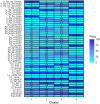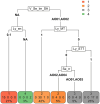Survey study on sentinel lymph node biopsy: indications and perceived value among small animal surgical specialists
- PMID: 40843246
- PMCID: PMC12365617
- DOI: 10.3389/fvets.2025.1591877
Survey study on sentinel lymph node biopsy: indications and perceived value among small animal surgical specialists
Abstract
Introduction: Despite the growing adoption of sentinel lymph node biopsy (SLNB) for nodal staging in dogs, standardized guidelines defining its specific indications remain lacking. This survey study aimed to assess the indications for SLNB among small animal surgical specialists and evaluate its perceived value.
Methods: An online survey was distributed through the European College of Veterinary Surgeons (ECVS), comprising five sections: clinical practice type, nodal staging, lymphadenectomy, mapping techniques, and the perceived value of SLNB. Descriptive statistics summarized responses, while cluster analysis explored associations between clinical practice type and SLNB recommendations.
Results: Seventy-four surgeons participated, with 74% practicing in non-academic and 26% in academic institutions. The majority (80%) performed lymphadenectomy with histopathological evaluation for nodal staging, and 53% recommended it for all malignant tumors, irrespective of nodal size. Additionally, 80% preferred SLNB over regional lymphadenectomy, particularly for specific tumor types (mast cell tumors, melanomas, carcinomas) or anatomical locations (oral tumors). Indirect CT lymphography was the most commonly used preoperative mapping technique (59.4%), yet only 23% of respondents combined preoperative and intraoperative mapping techniques. While 63% considered SLNB a reliable diagnostic tool, cluster analysis indicated that the type of clinical practice (academic vs. non-academic) did not influence SLNB recommendations.
Discussion: Despite a low response rate (8.3%), findings suggest that SLNB is widely performed by specialists across different practice settings, particularly for select tumor types. However, with 20% not performing SLNB and 37% uncertain about its reliability, these results highlight the need for standardized guidelines to define clear indications and improve consistency in clinical decision-making.
Keywords: cancer; dog; lymphadenectomy; sentinel lymph node; survey study.
Copyright © 2025 Chiti, Luconi, Ubiali, Boracchi, Stefanello and Nolff.
Conflict of interest statement
The authors declare that the research was conducted in the absence of any commercial or financial relationships that could be construed as a potential conflict of interest.
Figures


Similar articles
-
Prescription of Controlled Substances: Benefits and Risks.2025 Jul 6. In: StatPearls [Internet]. Treasure Island (FL): StatPearls Publishing; 2025 Jan–. 2025 Jul 6. In: StatPearls [Internet]. Treasure Island (FL): StatPearls Publishing; 2025 Jan–. PMID: 30726003 Free Books & Documents.
-
Sentinel lymph node biopsy followed by lymph node dissection for localised primary cutaneous melanoma.Cochrane Database Syst Rev. 2015 May 16;2015(5):CD010307. doi: 10.1002/14651858.CD010307.pub2. Cochrane Database Syst Rev. 2015. PMID: 25978975 Free PMC article.
-
Positron emission tomography (PET) and magnetic resonance imaging (MRI) for the assessment of axillary lymph node metastases in early breast cancer: systematic review and economic evaluation.Health Technol Assess. 2011 Jan;15(4):iii-iv, 1-134. doi: 10.3310/hta15040. Health Technol Assess. 2011. PMID: 21276372 Free PMC article.
-
Changing practice patterns in axillary management for patients with node-positive breast cancer towards increased use of sentinel lymph node biopsy-alone after neoadjuvant chemotherapy: results of a survey (MF17-01) among Turkish surgeons.Langenbecks Arch Surg. 2025 Jun 16;410(1):196. doi: 10.1007/s00423-025-03767-9. Langenbecks Arch Surg. 2025. PMID: 40522373 Free PMC article.
-
Sentinel Lymph Node Biopsy in Cutaneous Melanoma: Standard and New Technical Procedures and Clinical Advances. A Systematic Review of the Literature.Clin Nucl Med. 2016 Dec;41(12):e498-e507. doi: 10.1097/RLU.0000000000001370. Clin Nucl Med. 2016. PMID: 27749418
References
-
- Guerra D, Faroni E, Sabattini S, Agnoli C, Chalfon C, Stefanello D, et al. Histologic grade has a higher-weighted value than nodal status as predictor of outcome in dogs with cutaneous mast cell tumours and overtly metastatic sentinel lymph nodes. Vet Comp Oncol. (2022) 20:551–8. doi: 10.1111/vco.12806 - DOI - PubMed
LinkOut - more resources
Full Text Sources

